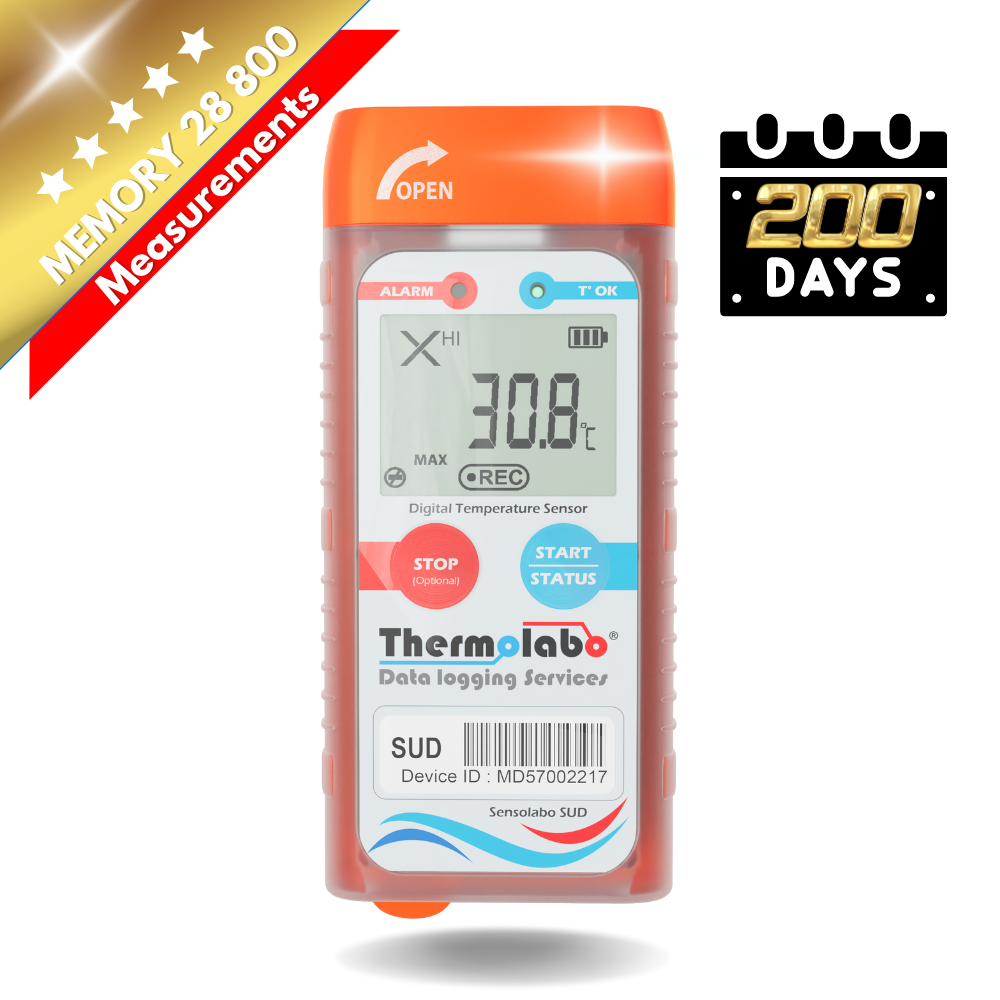USB Temperature Data Logger: The Essential Device for Monitoring Temperature-Sensitive Products
A USB temperature data logger is an electronic device designed to record and store temperature data accurately. It is widely used in sectors such as the pharmaceutical, food, and logistics industries, where cold chain management is crucial to ensure the safety and quality of temperature-sensitive products. When connected to a local computer via a USB port, this device provides a detailed history of the recorded data, ensuring rigorous monitoring of storage and transport conditions.
What Is a USB Temperature Data Logger?
The USB temperature data logger, also known as a data logger USB, is designed to monitor the environmental conditions of a temperature-sensitive product, whether during transport or storage. Placed near the products it is monitoring, it allows, after a set period, to verify whether the temperature conditions have been within the acceptable range. This device is widely used in industries such as food, pharmaceuticals, laboratories, and refrigerated transport.
Typically, it comes in the form of a USB stick. The dimensions and shape may vary depending on the manufacturer, but the core components remain the same: a logger that captures temperature data at regular intervals and may be reusable or single-use, depending on the specifications. Some models are also equipped with an LCD screen to display real-time temperature readings.
USB Temperature Data Logger vs Temperature Indicator: What’s the Difference?
It is essential to differentiate between a temperature data logger and a temperature indicator, as these two devices serve different purposes. A temperature data logger is similar to a photograph: it captures a series of data over time, allowing the temperature to be monitored at multiple points throughout the period. Thanks to its internal clock, it timestamps each measurement, providing a full historical record of the conditions in which the product was stored.
On the other hand, a temperature indicator only provides a snapshot: it simply shows if the temperature has exceeded the acceptable limits, without indicating when this happened or for how long. It’s a basic visual tool that doesn’t provide the ability to track temperature fluctuations over time.
The Evolution of USB Temperature Data Loggers
The first USB temperature data loggers appeared in the late 1990s. Initially, these devices required software to be installed on a computer to read the data. However, with technological advancements, by the mid-2000s, these data loggers evolved. Today, they are capable of automatically generating PDF reports and temperature graphs as soon as they are connected to a computer. The data logger then functions as a regular USB drive, from which the user simply retrieves the PDF report detailing the recorded data history.
The Limitations of USB Data Loggers in a Strict Regulatory Environment
Although USB data loggers have simplified temperature data management, their use faces challenges, especially in sectors such as the pharmaceutical industry, where regulatory and security requirements are becoming increasingly stringent. One of the main challenges with these devices is the need to manually extract and transfer the files for analysis, which can introduce risks of human error and data loss.
Additionally, removable USB storage devices are increasingly vulnerable to cyberattacks. Companies focused on data security and IT infrastructure are starting to limit the use of these devices. The growing security requirements further restrict the use of USB storage, making these devices a less secure option.
Securing Data: Sensolabo SUD and File Authentication
Despite these challenges, USB temperature data loggers remain one of the simplest and most accessible ways to monitor temperature-sensitive products. Modern solutions like Sensolabo SUD provide an interesting alternative by ensuring the integrity of the data. Sensolabo SUD integrates a proprietary file verification and authentication system when storing data on the cloud, securing the data throughout the process.
The system also allows for a complete audit of the software code and ensures that only trusted subcontractors are involved in manufacturing, thus minimizing IT security risks. This approach guarantees total control over cybersecurity, which is essential in an environment where regulatory and security requirements are more demanding than ever.
Why Choose a USB Temperature Data Logger?
USB temperature data loggers remain a popular choice for many businesses because of their ease of use and affordability. Their ability to generate detailed PDF reports in just a few simple steps and their broad compatibility with local computers make them an indispensable tool for many industries. However, to address the challenges associated with data security and regulatory compliance, it’s essential to choose integrated, secure solutions like Sensolabo SUD, which ensure the integrity of the collected data.
In conclusion, if you’re looking for an effective solution to monitor the temperature of your temperature-sensitive products while ensuring compliance with safety standards, the USB temperature data logger is a smart choice. But to go further and protect your data, prioritize advanced solutions that integrate robust security systems.
Explore Our USB Temperature Data Logger Solutions
To learn more about our USB temperature data logger and humidity monitoring solutions, feel free to explore our products and services by clicking HERE. Ensure the safety of your temperature-sensitive products with reliable and secure temperature monitoring devices.


Write a Comment